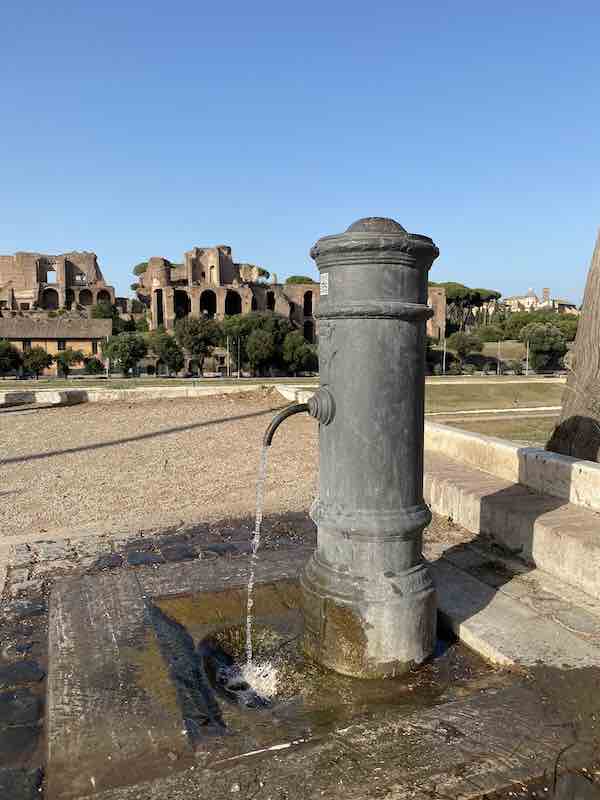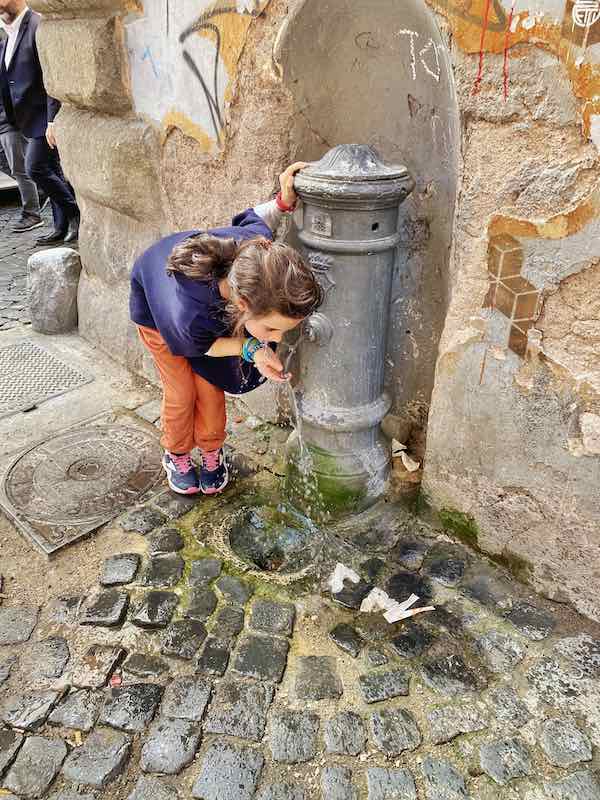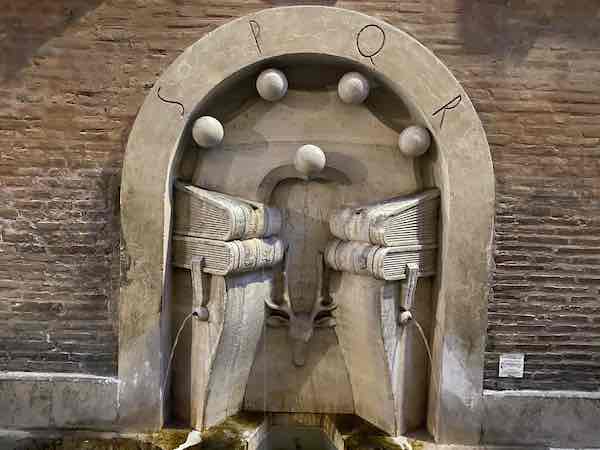All you need to know about Rome drinking fountains: discover the most iconic drinking fountains of Rome, i nasoni, how to drink from them and where else you can find free drinking water in Rome
Rome has a staggering number of drinking fountains, offering delicious, refreshing and ever flowing clean drinking water.
In Italian, we call them fontanelle aka small drinking fountains and while you have fontanelle all over Italy, they have a special connection with Rome, the city with the highest number of them!
You find them all over the city, in the city center especially, and they come in several shapes.
Some are works of art, each with individual appearance (fontanelle rionali); some are modern water dispensers with a handy function yet no art or history about them; some have a peculiar appearance, thy of a cast iron main body with a long curved spout that resembles a nose (I nasoni).
Nasoni and fontanelle in general are a great resource: the water they offer is safe (read here about tap water in Rome), fresh and with great taste; they are free to use and there are so many of them, you may find you don’t even need to lug a water bottle around with you, since you can just stop and drink from them directly.
In this post, I share useful and interesting info about the drinking fountains in Rome and my local tip on how to drink from i nasoni. I hope you enjoy it!
Important: always check fountains for signs that say ‘acqua non potabile’. This sign means the water is not for drinking so if you see it, do not drink from there!
I Nasoni – what they are, how to drink from them how to find them
I nasoni are the most typical type of drinking fountain in Rome.
Le fontanelle first appeared in Rome in 1874, when the Comune (Rome’s municipal administration) built them to distribute clean, drinkable water to the capital for free and we now have 2500 of them!
Nasoni are made of a cast iron main body that looks like a cylinder with a pretty top and, on their side, the sport a long curved spout from where water flows freely.
The spout resembles a long nose and this is what gave these fountains their name: nasone in Italian means ‘big nose’!
The Nasoni are peculiar to the city of Rome: they offer deightfully fresh drinking water and deliver it in a unique way that makes them unforgettable, especially if you are visiting Rome with kids!
There is however one thing to know about the nasoni and this is how to use them. While you can just drink from the spout as the water comes out, there is a small trick that makes the whole process more fun. Here it is!

As you get close to a nasone, place yourself to the side of it (either side). Then, place the palm of your hand or your fingers under the water spout, to stop the follow of water.
This gesture will force the water to come up out of The small hole at the top of the spout (the nose), and you will see it will come out in a gentle arch!
You can now gently put your mouth to the water and drink at leisure, without your lips ever touching the iron nor your back getting sore from excessive bending!
It is as simple and as fun as this!

You’ll encounter drinking fountains as you stroll, but you can also find a map here.
Other fountains in Rome: fontane rionali
As well as nasoni, you have other fountains in Rome, some of them with a really interesting story: fontanelle rionali.
Fontane Rionali are a series of fountains dating from 1926: that year, architect Pietro Lombardi was commissioned with the design of a series of fountains that were to replaces older damaged one and he came up with an idea.
He decided to design each fountain differently, giving each of them a shape that recalled something specific about the area they were in. He came up with 10 of them, some still in existence. They are:
- Fontana delle Arti, on via Margutta (Fountains of the arts) – a homage to the traditional presence of artists and art galleries in this road
- Fontana delle Anfore in Testaccio (Amphoras’ Fountain) – a homage to the large number of shards of ancient amphorae found in this area (so many, they created an artificial mount, Monte dei Cocci)
- Fontana della Botte in Trastevere (Fountain of the barrel) – recalling the flourishing food and drink commerce of this area
- Fontana dei Libri in Sant’Eustachio (Fountain of the books) – beside the ancient seat of the University
- Fontana delle stelle in Monti (Fountains of the stars), decorated with the coat of arms of this areas
- Fontana delle Tiare near the Vatican (Tiaras’ fountain) – decorated with Papal symbols
- Fontana delle Palle di Cannone in Borgo, Vatican (Fountain of the cannon balls) inspirited by nearby Castel Sant’Angelo
- Fontana del Timone in Ripa) (Fountain of the Rudder) – recalling the maritime vocation of this area
- Fontana della Pigna in Piazza Venezia (Fountain of the Pinecone) – inspired by the name of the area and it’s symbol



These fountains tend to be drinking fountains but always check local signage. Should is say ‘acqua non potabile’ it means you should not drink from it.
Fontanelle della Lupa Imperiale
Another cool type of drinking fountain is the so called Fountain of the Imperial Wolf, now quite rare and mostly found in parks.
These fountains are made of travertine (stone) and take their name from the shape of their water spout, which is carved to look like a she wolf.
Now, very few of them have the wolf head, but the fontanelle is still there, and you can drink from them, remembering Romulus, Remus, the Roman she-wolf and the long story the humble fountain commemorates.
Other drinking fountains in Rome
As well as these more unique drinking fountains, you will find several others in Rome, along the streets, in piazzas and parks.
Some of them are historic, some of them are not: for instance, beside the Colosseum you now have a water dispenser which is basically the equivalent of an office water cooler.
When you come across a fountain in Rome, you need to look at it to gauge whether it is for drinking or not.
In general, small fountains have drinking water but always check for signs to this effect: if the water is NOT drinkable, the sign will say ‘acqua non potabile‘
On the other hand, monumental fountains are usually not drinking fountains: always look for a nasone instead.
How to find drinking fountains in Rome
You’ll encounter drinking fountains as you stroll, but you can also find a map here.
We Romans are very proud of our drinking fountains, and le fontanelle are now at the heart of a project called ‘free to drink’, that campaigns for their survival against the trend that wants us buy water in plastic bottles. I hope you’ll find them as refreshing as we do!
Safe travels!

